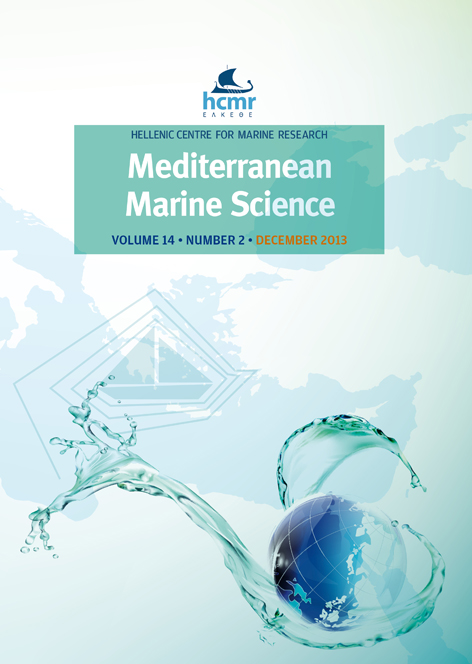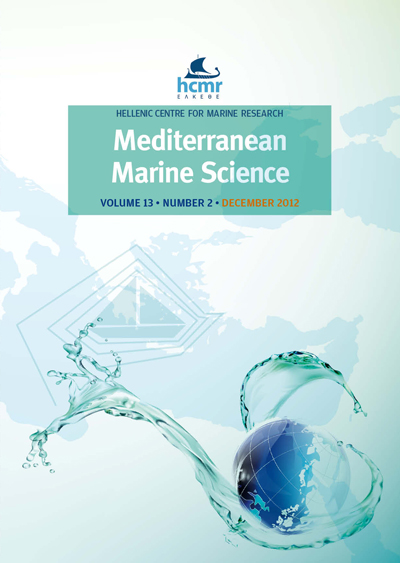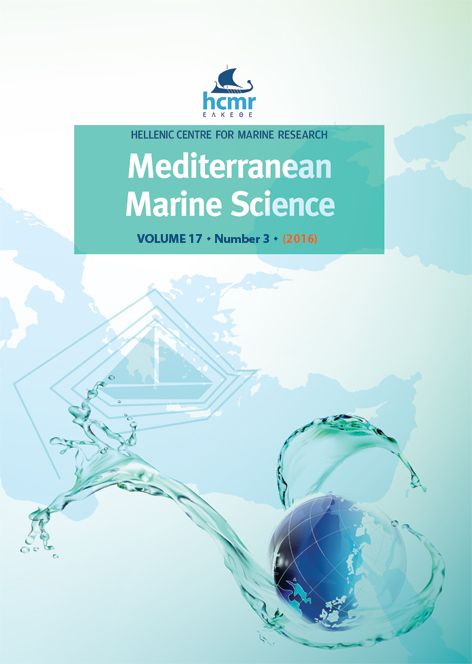Temporal variation of the algae-associated molluscan assemblage of artificial substrata in Bay of Tunis (Tunisia)

Abstract
The molluscan assemblage inhabiting the photophilous algae from artificial rocky shores in theBay of Tunis) was studied from February 2009 to February 2010. Five monthly replicates were taken with a quadrat of 25 × 25 cm .. A total of 16105 individuals of molluscs, belonging to 93 species, were collected. Gastropods were the most species-rich group, with 66 species (70.96%), followed by bivalves with 26 species (27.95%). Gastropods were also the most abundant with 11529 individuals (71.60%), followed by bivalves with 4575 individuals (28.41%). Nevertheless,Mytilaster minimus was the dominant species overall during the studied period (15.6% of total abundance), followed by Tricolia miniata (11.6%), Bittium reticulatum (11.5%), Gibbula racketti (10.4%) and Rissoa similis (9.8%). The high abundance of juveniles of soft (e.g. Venerupis aurea, Nassarius corniculum) and hard bottom species (e.g. M. minimus, Fissurella nubecula) point out the important role of this habitat as nursery for species from nearby located habitats. The presence of the alien molluscs Mitrella psilla (2.5% dominance) and Arcuatula senhousia highlights the importance of algae as vehicle and/or receptor habitat for alien species.
Species richness and abundance displayed significant seasonal changes, with maxima in winter 2009, but the Shannon-Wiener diversity index showed similar values throughout the year. Multivariate analyses also indicated the presence of significant seasonal differences of this molluscan assemblage.
Article Details
- How to Cite
-
ANTIT, M., DAOULATLI, A., RUEDA, J., & SALAS, C. (2013). Temporal variation of the algae-associated molluscan assemblage of artificial substrata in Bay of Tunis (Tunisia). Mediterranean Marine Science, 14(2), 390–402. https://doi.org/10.12681/mms.379
- Issue
- Vol 14, No 2 (2013)
- Section
- Research Article
Authors who publish with this journal agree to the following terms:
- Authors retain copyright and grant the journal right of first publication with the work simultaneously licensed under a Creative Commons Attribution Non-Commercial License that allows others to share the work with an acknowledgement of the work's authorship and initial publication in this journal.
- Authors are able to enter into separate, additional contractual arrangements for the non-exclusive distribution of the journal's published version of the work (e.g. post it to an institutional repository or publish it in a book), with an acknowledgement of its initial publication in this journal.
- Authors are permitted and encouraged to post their work online (preferably in institutional repositories or on their website) prior to and during the submission process, as it can lead to productive exchanges, as well as earlier and greater citation of published work (See The Effect of Open Access).
Downloads
References
Andrew, N.L., Jones, G.P., 1990. Patch formation by herbivorous fish in a temperate Australasian kelp forest. Oecologia, 85, 57-68.
Antit ben Rejeb, M.., 2012. Caractérisation des communautés de Mollusques dans des milieux littoraux de la .baie de Tunis. Thèse de Doctorat, Université de Tunis – El Manar, 400 pp.
Antit, M., Azzouna, A., 2012. Mollusques des milieu littoraux de la baie de Tunis. Iberus, 30(2), 107-133.
Antit M., Gofas S., Azzouna A., 2010. A gastropod from the tropical Atlantic becomes an established alien in the Mediterranean. Biological Invasions, 12(5), 991-994.
Antit M., Gofas S., Salas C., Azzouna, A., 2011. One hundred years after Pinctada: an update on alien Mollusca in Tunisia. Mediterranean Marine Science, 12(1), 53-73.
Arroyo, M.C., Salas, C., Rueda J.L., Gofas, S., 2006. Temporal changes of mollusc populations from a Zostera marina bed in southern Spain (Alboran Sea), with biogeographic considerations. Marine Ecology: An Evolutionary Perspective, 27, 417-430.
Ballesteros, E, Pinedo, S., 2004. Los bosques de algas pardas y rojas. Pp. 199-222. In: Praderas y bosques marinos de Andalucía, Luque, Á.A., Templado, J. (Eds.). Consejería de Medio Ambiente, Junta de Andalucía, Sevilla, 336 pp.
Bayed A., Bazairi H., 2008. Inter-annual variations of soft bottom benthic macrofauna of the Oued Laou bay (Alboran Sea, Morocco). Travaux de l´Institut Scientifique, Rabat, 5, 99-106.
Bégin C., Johnson L.E., Himmelman. J.H., 2004. Macroalgal canopies: distribution and diversity of associated invertebrates and effects on the recruitment and growth of mussels. Marine Ecology Progress Series, 271, 121-132.
Beisner, B.E., Hovius, J., Hayward, A., Kolasa, J., Romanuk T., 2006. Environmental productivity and biodiversity effects on invertebrate community invasibility. Biological Invasions, 8(4), 655-664.
Brown, V.B., Davies, S.A., Synnot, R.N., 1990. Long-term monitoring of the effects of treated sewage effluent on the intertidal macroalgal community near Cape Schanck, Victoria, Australia. Botanica Marina, 33, 85-98.
Bussell, J.A., Lucas, I.A.N., Seed, R., 2007. Patterns in the invertebrate assemblage associated with Corallina officinalis in tide pools. Journal of the Marine Biological Association of United Kingdom, 87, 383-388.
Cecalupo, A., Buzzurro, G., Mariani, M., 2008. Contributo alla conoscenza della malacofauna del golfo di Gabes (Tunisia). Quaderni della Civica Stazione Idrobiologica di Milano, 31, 1-267.
Chemello, R, Milazzo, M., 2002. Effect of algal architecture on associated fauna: some evidence from phytal molluscs. Marine Biology, 140, 981-990.
Chemello, R, Russo, G F, 1997. The molluscan taxocoene of photophilic algae from the Island of Lampedusa (Strait of Sicily, southern Mediterranean). Bollettino Malacologico, 33, 95-104.
Chemello, R, Di Piazza, F, Dieli, T, Riggio, S, 1997. Structure of the molluscan fauna associated to photophilous algae: effects of depth and habitat complexity. Biologia Marina Mediterranea, 4(1), 167-168
Christie, H., Norderhaug, K.M., Fredriksen, S., 2009. Macrophytes as habitat for fauna. Marine Ecology Progress Series, 396, 221-233.
Clarke, K.R., Warwick, R.M., 1994. Change in marine communities: an approach to statistical analysis and interpretation. Plymouth Marine Laboratory, Plymouth
Costa, A.C., Ávila, S.P., 2001. Macrobenthic mollusc fauna inhabiting Halopteris spp. subtidal fronds in São Miguel Island, Azores. Scientia Marina, 65 (2), 117-126.
Dhargalkar, V.K., Komarpant, D.S., 2003. Impact of sewage on the distribution, abundance and community structure of rocky intertidal macroalgae of the Colaba coast, Mumbai, India. Seaweed Research and Utilization, 25 (1-2), 27-36.
Edgar, G.J., 1983. The ecology of South-East Tasmanian phytal animal communities. I. Spatial organization on a local scale. Journal of Experimental Marine Biology and Ecology, 70, 129-157.
Fekih, M., Gougerot, L., 1974. Liste commentée des Gastéropodes testacés marins recueillis dans les dépôts littoraux actuels du Golfe de Tunis. Bulletin de l’Institut National Scientifique et Technique d'Océanographie et de Pêche, Salammbô, 3(1-4), 165-232.
Fridley, J.D., Stachowicz, J.J., Naeem, S., Sax, D.F., Seabloom, E.W., Smith, M.D., Stohlgren, T.J., Tilman, D., Von Holle, B., 2007. The invasion paradox: reconciling pattern and process in species invasions. Ecology, 88(1), 3-17.
Glémarec, M., 1964. Bionomie benthique de la partie orientale du Golfe du Morbihan. Cahiers de Biologíe Marine, 5, 33-96.
Gofas, S, Moreno, D, Salas, C. (Eds.), 2011. Moluscos marinos de Andalucía. Vol I and Vol. II. Servicio de Publicaciones e Intercambio Científico, Universidad de Málaga, Málaga, 798 pp.
Jeffrey, S., Humphrey, G.T., 1975. New spectrophotometric equations for determining chlorophylls a, b, c1 and c2 in higher plants, algae and phytoplankton. Biochemical Physiology, 167, 191–194.
Kelaher, B.P., 2003. Changes in habitat complexity negatively affected diverse gastropod assemblages in coralline algal turf. Oecologia, 135, 431-441.
Kelaher, B.P., Castilla, J.C., 2005. Habitat characteristics influence macrofaunal communities in coralline turf more than mesoscale coastal upwelling on the coast of Northern Chile. Estuarine, Coastal and Shelf Science, 63, 155-165.
Kelaher, B.P., Chapman, M.G., Underwood, A.J., 2001. Spatial patterns of diverse macrofaunal assemblages in coralline turf and their associations with environmental variables. Journal of the Marine Biological Association of United Kingdom, 81, 917-930.
Kelaher, B.P., Castilla, J.C., Prado,L., York, P., Schwindt, E., Bortolus, A., 2007. Spatial variation in molluscan assemblages from coralline turfs of Argentinean Patagonia. Journal of Molluscan Studies, 73, 139-146.
Krebs, C.J., 1989. Ecological methodology. Harper and Row Publishers, New York, 645 pp.
Liddle, M.J, 1991. Recreation ecology: Effects of trampling on plants and corals. Trends in Ecology and Evolution, 6(1): 13-17.
Littler, M.M., Martz, D.R., Littler, D.S., 1983. Effects of recurrent sand deposition on rocky intertidal organisms: importance of substrate heterogeneity in a fluctuating environment. Marine Ecology Progress Series, 11, 129-139.
Menioui, M., 1992a. Etude faunistique et écologique des peuplements infralittoraux superficiels des côtes rocheuses du Maroc. III - Peuplement à Cystoseira fimbriata. Bulletin de l'Institut Scientifique, Rabat, 16, 87-93.
Menioui, M., 1992b. Etude faunistique et écologique des peuplements infralittoraux superficiels des côtes rocheuses du Maroc. IV - Peuplement à Cystoseira stricta. Bulletin de l'Institut Scientifique, Rabat, 16, 94-101.
Milazzo, M, Chemello, R, Badalamenti, F, Riggio, S, 2000. Molluscan assemblages associated with photophilic algae in the Marine Reserve of Ustica Island (Lower Tyrrhenian Sea, Italy). Italian Journal of Zoology, 67(3), 287-295.
Milazzo, M., Badalamenti, F., Riggio, S., Chemello, R., 2004. Patterns of algal recovery and small-scale effects of canopy removal as a result of human trampling on a Mediterranean rocky shallow community. Biological Conservation, 117(2), 191-202.
Pallary, P., 1914. Liste des Mollusques du Golfe de Tunis. Bulletin de la Société d’Histoire Naturelle de l’Afrique du Nord, 6: 12-27.
Panayotidis, P., Montesanto, B., Orfanidis, S., 2004. Use of low-budget monitoring of macroalgae to implement the European Water Framework Directive. Journal of Applied Phycology, 16, 49-59.
Pasquaud, S., Pillet, M., David, V., Sautour, B., Elie, P., 2010. Determination of fish trophic levels in an estuarine system. Estuarine, Coastal and Shelf Science, 86, 237-246.
Pérès, J.M., Picard, J., 1964. Nouveau manuel de bionomie benthique de la Méditerranée. Recueil des Travaux de la Station Marine d’Endoume, 31, 1-137.
Pielou, E.C., 1969. An introduction to mathematical ecology. Wiley, New York, 286 pp.
Pohle, D.G., Bricelj, V.M., García-Esquivel, Z., 1991. The eelgrass canopy: an above-bottom refuge from benthic predators for juvenile bay scallops Argopecten irradians. Marine Ecology Progress Series, 74, 47-59.
Poulicek, M., 1985. Les mollusques des biocénoses à algues photophiles en Méditerranée: II. Analyse du peuplement. Cahiers de Biologie Marine, 26, 127-136.
Povey, A., Keough, M.J., 1991. Effects of trampling on plant and animal populations on rocky shores. Oikos, 61, 355-368.
Rueda, J.L., Salas, C., 2003. Seasonal variation of a molluscan assemblage living in a Caulerpa prolifera meadow within the inner Bay of Cádiz (SW Spain). Estuarine, Coast and Shelf Science, 57, 909–918.
Rueda, J.L., Salas, C., Marina, P., 2008. Seasonal variation in a deep subtidal Zostera marina L. bed in southern Spain (western Mediterranean Sea). Botanica Marina, 51, 92-102.
Rueda, J.L., Gofas, S., Urra, J., Salas, C., 2009. A highly diverse molluscan assemblage associated with eelgrass beds (Zostera marina L.) in the Alboran Sea: Micro-habitat preference, feeding guilds and biogeographical distribution. Scientia Marina, 73(4), 669-700.
Ruitton, S., Francour, P., Boudouresque, C.F., 2000. Relationships between algae, benthic herbivores invertebrates and fishes in rocky sublittoral communities of a temperate sea (Mediterranean). Estuarine, Coastal and Shelf Science, 50, 217-230.
Sales, M., Ballesteros, E., Anderson, M.J., Ivesa, L., Cardona, E., 2012. Biogeographical patterns of algal communities in the Mediterranean Sea: Cystoseira crinita–dominated assemblages as a case study. Journal of Biogeography, 39, 140-152.
Sánchez-Moyano, J.E., Estacio, F.J., García-Adiego, E.M., García-Gómez, J.C., 2000. The molluscan epifauna of the alga Halopteris scoparia in southern Spain as a bioindicator of coastal environmental conditions. Journal of Molluscan Studies, 66, 431-448.
Stachowicz, J.J., Byrnes, J.E., 2006. Species diversity, invasion success and ecosystem functioning: disentangling the influence of resource competition, facilitation and extrinsic factors. Marine Ecology Progress Series, 311, 251-262.
Stachowicz, J.J., Terwin, J.R., Whitlatch, R.B., Osman, R.W., 2002. Linking climate change and biological invasions: ocean warming facilitates non-indigenous species invasion. Proceedings of the National Academy of Sciences USA, 99, 15497-15500.
Urra J. 2012. Malacofauna del Lugar de Importancia Comunitaria “Calahonda” (Málaga, Sur de España): Patrones de distribución y dinámica temporal. Tesis doctoral, Universidad de Málaga.334 pp.
Woods, H.A., Podolsky, R.D., 2007. Photosynthesis drives oxygen levels in macrophyte-associated Gastropod egg masses. Biological Bulletin, 213, 88-94.
Worm, B., Lotze, H.K., 2006. Effects of eutrophication, grazing, and algal blooms on rocky shores. Limnology and Oceanography, 51, 569-579.
Zaouali J., 1978. Les peuplements malacologiques de la mer de Bou Grara. Bulletin de l'Office National des Pêches de Tunisie, 2(2), 199-209.








